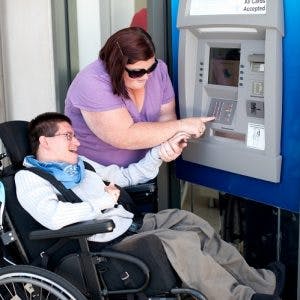About 15% of cerebral palsy cases result in dyskinetic CP, which is a motor disorder characterized by uncontrollable movements. As with all types of cerebral palsy, every person is affected differently.
For instance, one individual with dyskinetic CP may struggle with inward-facing feet while another individual may experience poor posture due to involuntary fluctuations in muscle tone. The effects vary greatly, which makes it essential to work closely with a therapist for individualized rehabilitation.
To help you better understand dyskinetic cerebral palsy, this article will explain:
- Causes of Dyskinetic Cerebral Palsy
- Signs & Symptoms of Dyskinetic Cerebral Palsy
- How to Manage Dyskinetic CP
Causes of Dyskinetic Cerebral Palsy
Dyskinetic cerebral palsy is caused by damage to the basal ganglia or thalamus before, during, or shortly after birth. Damage to these areas of the brain often causes abnormal muscle tone regulation, resulting in uncontrollable movements (dyskinesia) and irregular postures.
The basal ganglia are primarily responsible for motor control; however, they also play a role in motor learning, executive functions and behavior, and emotions. As a result, involuntary movements tend to become more severe when individuals are stressed or emotional.
Likewise, parts of the thalamus are involved in a complex set of neural pathways that affect movement. Therefore, damage to these areas can also cause involuntary movements.
Common causes of dyskinetic cerebral palsy include:
- Premature birth
- Stroke
- Birth complications
- Inadequate blood supply in the brain
- Traumatic brain injury
- Untreated jaundice
- Infection
Depending on the severity of the brain damage, individuals may experience a wide range of motor impairments. In the following section, we’ll discuss some of the defining characteristics of dyskinetic CP.
Signs and Symptoms of Dyskinetic Cerebral Palsy
Dyskinetic cerebral palsy is mainly characterized by two types of movement disorders: dystonia and choreoathetosis. They both generally affect the entire body; however, symptoms tend to be more severe in the arms than legs.
Often, individuals with dyskinetic CP experience both dystonia and choreoathetosis; however, they can also occur independently of each other.
Below, we’ll discuss the differences between these two movement disorders.
Dystonia
Dystonia is the most common and most noticeable movement disorder among individuals with dyskinetic cerebral palsy. It’s characterized by repetitive, twisting movements and abnormal postures caused by involuntary muscle contractions.
Common postures observed in individuals with dystonia include the inward-facing of the feet, outwards shifting of the wrist (ulnar deviation), and the inward curving of the lower back. These postures may occur in short intervals or last for prolonged periods.
Generally, dystonia occurs when individuals actively try to move. For some, it will only be triggered by certain movements. Moreover, signs of dystonia can worsen depending on stress levels and emotions.
Learn more about dystonic cerebral palsy »
Choreoathetosis
Choreoathetosis can be divided into chorea (which describes rapid, jerky movements) and athetosis (which is characterized by uncontrollable fluctuations in muscle tone).
Because the muscles may continuously shift between stiff and floppy, individuals often appear as if they are constantly moving. This can make it challenging to sustain a stable posture, grip objects, and perform tasks that require precision such as writing.
Generally, involuntary movements heighten when the individual is excited, upset, or anxious. These uncontrollable movements typically only cease when the individual is fully relaxed, distracted, or asleep.
Now that you understand the signs and symptoms of dyskinetic cerebral palsy, the next section will explore management interventions.
Dyskinetic Cerebral Palsy Management
As with all types of cerebral palsy, the brain damage that causes dyskinetic cerebral palsy is irreversible. However, there are ways to reduce uncontrollable movements and associated conditions like pain.
Below, we’ll discuss some of the most commonly used management interventions for dyskinetic CP.
Rehabilitative Therapies
Participating in rehabilitative therapies like physical therapy, occupational therapy, and speech therapy can help individuals with dyskinetic cerebral palsy manage their symptoms.
- Physical therapy promotes overall mobility and posture through strengthening exercises and stretches.
- Occupational therapy focuses on developing fine motor skills through activities of daily living. At occupational therapy, your child will learn how to use adaptive tools to expand their functional abilities.
- Speech therapy will strengthen the oral motor muscles to help individuals improve their chewing, swallowing, and speaking skills. They may also explore alternative forms of communication if needed.
Medications
Oral baclofen and anticholinergic drugs like trihexyphenidyl are most commonly used to manage dyskinetic cerebral palsy. However, they generally have low effectiveness because they cannot efficiently pass through the blood-brain barrier. Consequently, they need to be administered in greater doses, which increases the risk of adverse side effects.
Another option involves getting baclofen injected directly into the spinal canal through an intrathecal pump. It allows for a lower dose of the muscle relaxant to enter the body and decreases the risk of side effects.
This review found that intrathecal baclofen administration resulted in “significant decreases in dystonia and subjective improvements in mobility, speech and communication, swallowing, head control, sleep, pain and mood, comfort, and ease of care.”
Orthotics
Orthotic devices like compression garments and braces can help stabilize the body to prevent growth deformities caused by uneven muscle pull and reduce the effects of fluctuating muscle tone.
Against spasticity, orthotics will resist against the contraction. Against hypotonia, orthotics will provide stability to keep you upright and promote proper musculoskeletal alignment.
Dyskinetic CP: Key Points
Dyskinetic cerebral palsy is a type of cerebral palsy characterized by uncontrollable movements due to abnormal muscle tone regulation. Individuals with dyskinetic CP may demonstrate various movement disorders resulting in repetitive, twisting movements, poor posture, or jerky movements.
With the help of rehabilitative therapies, medications, and orthotics, individuals with dyskinetic CP can learn to manage their symptoms and significantly improve their quality of life. Now that you have a better understanding of what dyskinetic cerebral palsy is, we hope you take the appropriate steps to properly manage it and improve your quality of life.











